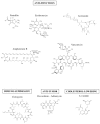Colibactin: More Than a New Bacterial Toxin
- PMID: 29642622
- PMCID: PMC5923317
- DOI: 10.3390/toxins10040151
Colibactin: More Than a New Bacterial Toxin
Abstract
Cyclomodulins are bacterial toxins that interfere with the eukaryotic cell cycle. A new cyclomodulin called colibactin, which is synthetized by the pks genomic island, was discovered in 2006. Despite many efforts, colibactin has not yet been purified, and its structure remains elusive. Interestingly, the pks island is found in members of the family Enterobacteriaceae (mainly Escherichia coli and Klebsiella pneumoniae) isolated from different origins, including from intestinal microbiota, septicaemia, newborn meningitis, and urinary tract infections. Colibactin-producing bacteria induce chromosomal instability and DNA damage in eukaryotic cells, which leads to senescence of epithelial cells and apoptosis of immune cells. The pks island is mainly observed in B2 phylogroup E. coli strains, which include extra-intestinal pathogenic E. coli strains, and pksE. coli are over-represented in biopsies isolated from colorectal cancer. In addition, pksE. coli bacteria increase the number of tumours in diverse colorectal cancer mouse models. Thus, colibactin could have a major impact on human health. In the present review, we will focus on the biological effects of colibactin, the distribution of the pks island, and summarize what is currently known about its synthesis and its structure.
Keywords: E. coli; cancer; colibactin; microbiota; pks; toxin.
Conflict of interest statement
The authors declare no conflicts of interest.
Figures





References
Publication types
MeSH terms
Substances
LinkOut - more resources
Full Text Sources
Other Literature Sources
Molecular Biology Databases
Miscellaneous

